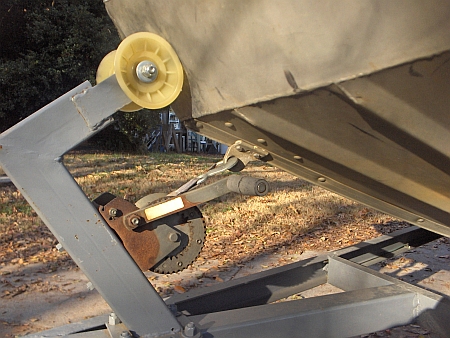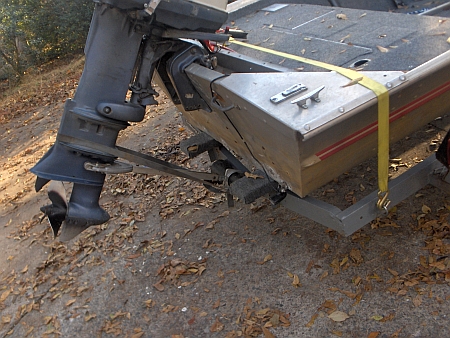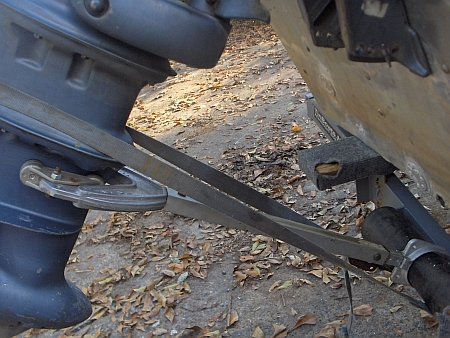This article is all about trailer tips. Judging from the number of questions I see on various message boards, it seems that trailer setup is a common problem among boat owners. A lot of anglers refuse to take the boat on short trips because it is not worth the trouble that is required to launch and retrieve the boat after each trip. Given what this site is geared towards, I am going to mainly talk about aluminum flat bottoms, mod vees, and semi vee fishing boats.
Bunk design:
First of all, I don’t believe in roller trailers. Anything that they can do, a bunk trailer can just as well, with other advantages. A common question I see asked is where to place the bunks and how long to make them. From my experience, long bunks are the best way to go, for small to medium aluminum boats. As far as placement, I usually like to put them about 2/3 of the way from the centerline to the edge of the hull, but most importantly, between chines, up against one of them, if possible. As far as length is concerned, longer is definitely better. On flat bottoms, I try to get them up to the point that the hull starts to slope upwards. On vee bottoms, I try to get them as long as possible, but there is the point at which they curve around too much, so you can only go so far.
Also, if your crossbars do not go far forward on the trailer, long bunks are not effective, as they need support, and can rarely be suspended more than a foot or so past the support point. Now, what is my reasoning for long bunks? I have found that they will not only support the boat better, but will also aid in loading. With short bunks, I have found that the boat will tend to float over the front, and then end up under the bow stop. With the longer bunks, the boat cannot slip in front of them, so they lift the bow up to the bow stop, as you float on. Now, in some cases, a couple supplementary keel rollers may be needed, as the steeper vee of the bow can often fit between the bunks, and scrape on the crossbar. However, I like to have my trailers set up to where the boat is not resting on them when loaded, and it just uses them to keep the hull off the frame while loading.
As far as getting the bunks mounted, there are many methods to choose. Many boat places will sell bunk brackets that bolt on with U-bolts, which keeps one from drilling holes in galvanized trailers, which will lessen the ability of the galvanization to properly protect. However, and another sturdy bracket will be perfectly suitable for bunk mounting. If the boat is a flat bottom, and the trailer doesn’t have the slanted crossbars, you can lay the bunks flat on the frame rails, and through bolt them with countersunk carriage bolts.
Winch posts:
A winch post is a pretty simple deal. Basically, it just needs to support a bow stop of some kind, and have a winch on it. The bow stop will vary depending on the type of boat. One a vee hull, a roller stop is generally ideal. However, on a flat Jon, you need something flat. A 2 foot wide 2 x 4, covered with carpet will do dandy. Also, you want your bow stop to be above the winch/bow eye. That way, in the event of an impact, or real abrupt stop, were the straps to fail, the bow eye will hang on the bow stop, and keep the boat out of your truck bed. Here is a picture of my winch post setup.

Tongue length:
Ideally, a longer tongue is ideal. Now, there are some times, when that is not practical, especially if you have to stick your boat in the garage or have to work with the trailer you have. However, if you have the option of a longer tongue, it is definitely an advantage. At shallow ramps, you can still launch and keep your truck dry. When having to get into the truck bed, with the trailer parked at an angle you can still get the tailgate open. On my 15.5 foot aluminum flat bottom, I have a 5.5-foot tongue, and wouldn’t sacrifice an inch of it.
Guide on’s:
Guide-on’s are not needed, but it is almost unanimously agreed that they are a convenience worth pursuing. There are many types. Tall PVC ones, short ones with rollers, or short ones with side bunks. All have their advantages, and there is no one that is better than another. They will give you a better visual on the trailer, when backing down the ramp, and will give you a point to aim between when loading. Also, in windy conditions, or in places of high cross current, they will keep the boat from floating off the side of the trailer. As another benefit, you can mount your lights on them, to have them at a more visible level, and keep them out of the water, if that is what you wish.
Tongue height and weight:
You will want to tow your trailer as close to level as possible and have between 7 and 12 percent of the total weight as tongue weight. This will aid in reducing sway, and make it a bit safer to tow at high speeds.
Strapping it down:
A lot of people are unsure as to what is needed to strap the boat down, and either over strap it, which hurts nothing, but uses a lot of time and effort or under strap it, which can be harmful to the hull. If set up correctly, the winch is enough to hold the bow. It is recommended, however, to have a supplementary catch up there, although my trailer doesn’t have one. This can be a foot long length of chain bolted or welded to the winch post, that has a hook to slip in the bow eye, or it can be a turnbuckle, which makes a rigid safety. For the stern, you have two options.
The first is to have a long ratchet strap that hooks on one side of the trailer, and goes over the gunwales, hooking on the trailer frame on the other side. The only thing is, you will want the strap to be close to the transom. The closer to the transom this strap is, the less it will stress the hull, bouncing down the road. This is what my trailer has:

However, the other option is to have a ratchet strap going from each stern ring to a tie point on the trailer. I favor the second option a bit more, but either way is acceptable, which is why my rig still has the first idea.
Outboard motor:
There has been controversy as to whether or not to use a transom saver, for as long as the transom saver has existed. For trailers with enough clearance to tilt the motor down into the run position, and not have any danger of the skeg grinding the road, when going over a speed bump or such, that is the best option. Just have a bungee, or strap going from the lower unit to the trailer frame, to keep the motor from bouncing. A tilt lock is not rigid enough, in most cases. A slight amount of preload is good for this, as it keeps the motor from rocking on the transom, which is much worse on a transom than punching WOT real quickly.
Now, if you lack the clearance to trailer in the down position, it is best to tilt it up and use a transom saver. If you don’t have power tilt, it is really your only option, as the factory hold tab on the motor is not designed to hold the motor while trailering. They will fail, and I have seen it happen, on numerous occasions. Also, you will need to strap it to the trailer in some way, as it can indeed bounce out, and let the motor tilt down really quickly. I just wrap a cam buckle tie down around the motor, and hook it to the trailer frame.

If you have power tilt, it is up to you as to whether or not you use one, but I would definitely recommend it. However, there are a few performance bass boats that recommend using some other trailering brackets, but for the most part, a transom saver would be your transom’s best friend.
The whole idea with strapping your boat and motor down is to make the boat, motor, and trailer move as one. Then, you can bounce down the roughest roads, and not have to worry about the boat bouncing around, and getting beaten to death.
Lights:
Trailer electrics are very simple actually. Provided, that the correct wires are joined together (they are color coded) if you have a problem, 99% of the time, it will be an issue with the ground. On trailers, usually, the ground is run through the trailer. On some of the better light kits, there is a 6 inch or so white wire running out of the light, that has a ring terminal on the end. Attach this to the trailer with a self-tapper, or pop rivet, and then do the same with the white wire coming out of the trailer plug, up at the coupler.
However, on some of the cheaper kits, the lights are grounded through the mounting studs. So, if your boltholes have paint in them, you will probably have a grounding issue. Thereby, you want to make sure to remove the paint from your light mounting holes, and then use star washers, to establish a good connection.
Now, when choosing your lights, you have two choices. Incandescent and LED lights.In my opinion, LED lights are worth every penny of the added expense, but in some cases, the finances don’t allow the expense, no matter how justifiable it is. In that case, the thing to do is unplug your lights before dunking your trailer. Otherwise, you can blow the fuse in the truck, and end up driving home with no dash lights, or trailer lights (not fun at midnight).
Also, submersible standard lights are usually anything but. I usually drill a drain hole in the bottom of the sealed light cases, as they will fill up with water, but being sealed, they won’t drain as quickly as they need to. Now, LEDs on the other hand, eliminate a lot of that worry. Plus, by having the lights on when loading at night, it is easier to see the trailer to load.
Maintenance:
There is the common “check all bolts and connections” phrase that most everybody has heard. That is 100% true. Lug nuts, coupler bolts etc. However, another thing to keep an eye on is the bearings. I am a firm believer in bearing buddies, but there are a lot of folks who don’t use them. No matter what way you choose, it is a good idea to tear into the hubs every year or so, to make sure water hasn’t gotten in there. Give each bearing a good once over, and check for rust or pitting, which would require them to be replaced. Also, glance at your springs every now and then, and make sure they aren’t cracked or pitted.
As far as spare gear to carry, it is always good to have a spare tire, as well as a jack and lug wrench. Often, the vehicle jack won’t work for the trailer. However, it is also nice to have a spare greased hub and bearings, especially if you go on a lot of long trips. But, if you keep everything up to par at a regular schedule, bearing trouble should be nonexistent.
Launching/Loading procedure:
Park out of the way of the ramp, in the parking lot. Unstrap the motor and transom straps, and load everything into the boat. Leave the bow hook attached. Back in the water, unhook, and float the boat off. Beach it, or tie to a dock, and then pull the trailer out to park. If you have a second person, a real easy method is to back in until the trailer wheels are wet, and then unhook the bow strap. With your buddy in the boat, back the rest of the way in, and hit the brakes. The boat will float off, and you can pull out.
For loading, back in and idle the boat on. Chances are, you will not get it right the first time.
Every boat/trailer combination will have a different depth that it loads best at. Generally, though, it is a lot shallower than how you launch. Ideally, you will want to have the trailer deep enough that when you idle on, the boat will rest on the bunks, and glide up to the winch post. It will take time to perfect that technique. The thing to remember is to launch deep, load shallow.
Trailering your boat should not be a hassle at all. With a little practice, the proper setup, and a bit of preventative maintenance, it should go smoothly and quickly, with no major snags.
I need to know how to mount transom roller to a round trailer
the bracket for the roller to a round surface